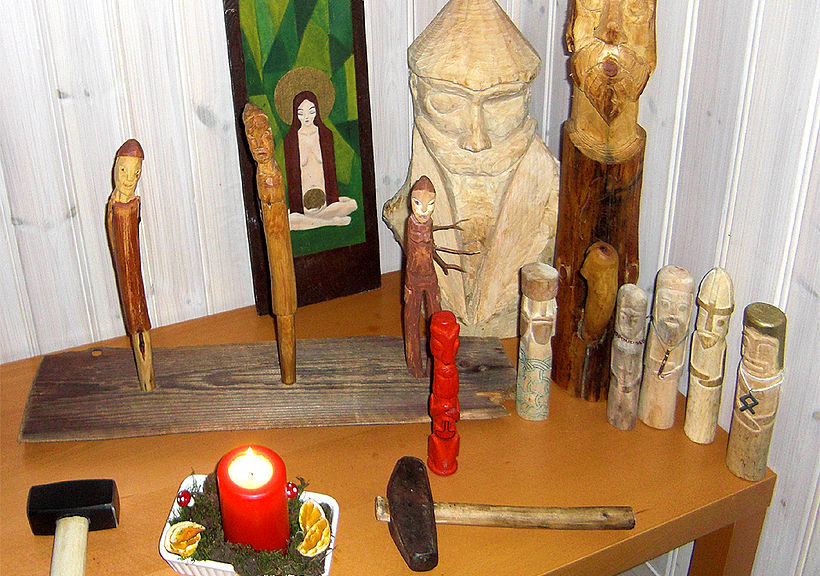
Creating Your Own Altars
Thanks to the requests of my patrons, I’ve got plenty to write about! Sheta Kay was kind enough to give me an idea for this next post. I’ve covered altars in the past, but probably not as much as I should. So, let’s talk about altars and how to construct one.
What were Altars Like in the Past?
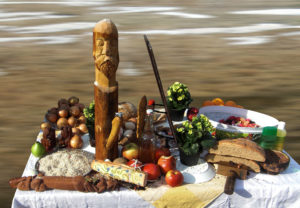 Because of Christianity, we really don’t have much information to go on when it comes to Heathen altars.. We can assume they set altars in the corner of the house. Most likely, they had small statues and other objects that they considered holy. Maybe they were significant to the wights of the area and the gods. Offerings were left at the indoor altar to the gods and local wights. and it was a place to reflect and pray.
Because of Christianity, we really don’t have much information to go on when it comes to Heathen altars.. We can assume they set altars in the corner of the house. Most likely, they had small statues and other objects that they considered holy. Maybe they were significant to the wights of the area and the gods. Offerings were left at the indoor altar to the gods and local wights. and it was a place to reflect and pray.Outdoor altars were typically made of stones in a cairn-like formation, or as wooden staves with the gods’ and wights’ faces carved into the pole. The Northern people drove these staves into the ground in sacred places. People probably left offerings and performed blots there.
What Did People Consider Holy Ground?
We’ve all heard of holy ground—certainly in vampire movies and other stories. But the concept of holy ground was not just confined to 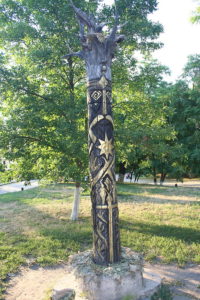 Christianity. As a matter of fact, our ancestors understood thresholds very well. As a result, they ringed their hofs (temples) with fences made from stone or wood. The inside yard, Heathens called a hörgr, and everything within it was considered holy.
Christianity. As a matter of fact, our ancestors understood thresholds very well. As a result, they ringed their hofs (temples) with fences made from stone or wood. The inside yard, Heathens called a hörgr, and everything within it was considered holy.
 Christianity. As a matter of fact, our ancestors understood thresholds very well. As a result, they ringed their hofs (temples) with fences made from stone or wood. The inside yard, Heathens called a hörgr, and everything within it was considered holy.
Christianity. As a matter of fact, our ancestors understood thresholds very well. As a result, they ringed their hofs (temples) with fences made from stone or wood. The inside yard, Heathens called a hörgr, and everything within it was considered holy.The interesting part about the hof and hörgr was that they weren’t always used as a place of worship. The people held town meetings and thing within a hof. The hörgr might have merchants and temporary shops in an open-air market set up for people to trade and buy things.
Hof and Hörgr
Nowadays, most of us Heathens are a scattered bunch, and with COVID-19, we may be scattered even more for some time. It’s unlikely that having a hof and hörgr in most communities will happen for some time, since Heathenism is a small religion, when compared with Christianity, or even Wicca.
Creating Your Own Indoor Altar
Creating your indoor altar is relatively easy. Choose a piece of furniture, or even a shelf on a book case, and add your statues and images of the gods and wights as you see fit. You may not have the money to purchase those statues, so if you’re artistically inclined, draw or paint your own. Or maybe bring in things that remind you of the certain gods. For example, I have wolves for Tyr and Skadi, a fox for Loki, horses for Freyr and Odin, Mjolnir for Thor, and a cat for Freyja. I also have stones, feathers, and elder branches for the wights.
Outside Altars
I have instructions for creating your own outdoor altar HERE. The instructions are for a cairn, but you can also create your own outdoor altar by creating or buying staves and putting them 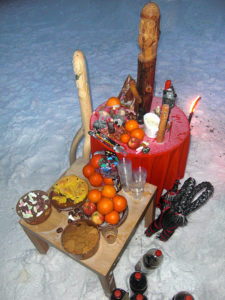 in a special spot in your yard. I’ve heard of people using sticks, or even tongue depressors and drawing the pictures of the gods on them using permanent markers. You can also write the names of the gods you wish to honor on the stick in runes and use them that way.
in a special spot in your yard. I’ve heard of people using sticks, or even tongue depressors and drawing the pictures of the gods on them using permanent markers. You can also write the names of the gods you wish to honor on the stick in runes and use them that way.
 in a special spot in your yard. I’ve heard of people using sticks, or even tongue depressors and drawing the pictures of the gods on them using permanent markers. You can also write the names of the gods you wish to honor on the stick in runes and use them that way.
in a special spot in your yard. I’ve heard of people using sticks, or even tongue depressors and drawing the pictures of the gods on them using permanent markers. You can also write the names of the gods you wish to honor on the stick in runes and use them that way.I hope I’ve given you some ideas when it comes to creating your own altar. Tell me how you did in the comments and add a photo of your altar! I’d love to see it.
I’m giving a shout out to my patron, Sarah Keene, for her support on Patreon. Her donation, along with all my other patron supporters, is the reason why I’m able to continue this blog. Thank you for your support!
Did you know you can become my patron for as little as $5 a month? This entitles you to content not posted anywhere else. Plus you get to see posts like this three days before the public! Without patrons, I’d be having a very hard time keeping this blog going. Become a patron today!



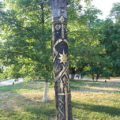
2 thoughts on “Creating Your Own Altars”
We actually have a wealth of information about the appearance, location in homes, items placed on the altars, etc., Just look East; archaeology has unearthed thousands of years of of pre christian Danube basin culture artifacts for almost 2 decades…
Good point. Thanks for the comment!